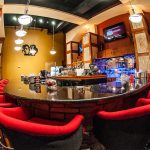Club security expert and former police officer Robert Smith outlines the ways in which your club’s security staff can help your club identify and/or deter an active shooter.
Bouncer: Brut, a thug, an unintelligent guy who’s job is to just toss unruly guests to the sidewalk in between checking I.D.’s and looking for drunk guests. Not anymore folks!
This stupid and incorrect stereotype has been slowly evolving for the good over the years. I’ve even had some pretty heated discussions about using the name “bouncer” and what guests think of “bouncers”. A few owners and managers, not all, have the impression that guests will not come to their bar or club if they call security team employees “bouncers”. I totally understand their fear, even if I don’t agree. One of our clients even uses the title “Beverage Ambassadors for their security team. Okay.
My solution to change any guest perception is fairly simple; raise your standards surrounding hiring and training of your security team. This story is a direct reflection of how necessary and important I feel the job, and training of our bar and club bouncers is. Here’s a scary scenario for you to ponder:

A Syrian family consisting of a 23-year-old male, his young sister, his mother and the grandmother all live in a small Syrian city. For this story, let’s call our male character Adnan. Adnan is unmarried and has no children and has hated America and all western ways since he can remember. He cares for his family and based on the war raging in Syria, they’re invited to become refugees in Canada where they can live in peace and free from all the “bad” elements.
Adnan and his family fly to Canada, are welcomed, interviewed, given temporary documents and allowed to start their new lives in Canada. Over the next year, all of them embrace their refugee status and are eventually given Canadian citizenship. Now with a new legal Canadian Passport, Adnan legally crosses our border and visit’s our national capital.
While in Washington, D.C. he locates a suitable target; one with easy entry, plenty of people and a chance to have a high death toll – a sidewalk café/restaurant/bar. He takes photos, video and even talks to the nighttime door host and learns that Friday nights after 10pm are the busiest time of the night. Adnan returns to Canada with his “target” set.
Once in Canada Adnan ponders his task. He knows he is on the “grid” when he uses his legal Canadian Passport. He then searches the Internet until he discovers one of many nearly invisible websites to order a counterfeit identification. He uses his real name, vital statistics and address for his $300 dollar Internet fake identification. Adnan has thought this through and knows he can cross back into the U.S. with his Canadian Passport and then use his “China Fake” identification to access his target for continued surveillance and his eventual Act of Terrorism.

Several weeks go by and Adnan uses his fake identification several times to visit the hospitality target in preparation. In final preparation he decides to visit the location at it’s busiest and stands in line to enter about 11pm on a Friday night.
As he gets to the front of the line, the bouncer, watching the guests in line, sees Adnan appears to be under the age of 30 and, following his bar policy, asks for Adnan’s identification. Adnan, confidently hands the bouncer his “China Fake” identification and fully expects to have it inspected without issue.
However, this isn’t just a bouncer, he’s a trained professional with a unique set of skills. The door host examines the ID and notices a unique “sheen” to the front of the ID. This is the first red flag that leads to several others. He then notices the light reflective hologram is exactly what a real ID from that state would have but it’s just not as clear. He then cups the ID in his hand and lightly folds it and BAM; the thin, inexpensive microfilm covering the front of the ID buckles and forms a raised fold across the front.
Simultaneously, the bouncer immediately knows the ID is an Internet fake and places the ID in his pocket and politely moves Adnan out of line to talk to him. Adnan lightly protests but doesn’t make much of a scene and leaves without his fake identification.
So, what happens next? Well, Adnan, our terror suspect, walks away, scared and frustrated, but he gets to walk away. He can’t gain access to the bar to complete his act of terrorism, unless he uses his real Canadian Passport, which he won’t do. So, for now at least, he has to re-group and re-plan his attack.
This is a great win for the bouncer, even if he doesn’t realize what he’s done, right? Is there more that could have been done? I think there is absolutely more that could be done. The next several points surround understanding the seriousness of the problem and what we must consider once a bad, borrowed or Internet fake identification is discovered.
Warning #1: Our industry and all owners must view the recent “active shooter” attacks as a deadly wake up call.
The highest level of security at most bars or clubs is normally a guy in an XXL shirt. We have to admit that to terror suspects worldwide, the hospitality industry is a soft target. This simply means our industry is an easy mark with plenty of potential casualties.
Warning #2: Normally, we’re not worried much about a 20-year-old with a borrowed or Internet identification—but you should be.
We catch them, keep the ID and turn them away. Please reassess what used to be a very straightforward issue and realize that terror suspects are our largest worry regarding the best forms of fake identification, the “China Fakes.” These I.D.’s are good. When used at your door will scan on any machine, they will have the correct black light holograms and will appear so good that only by authorities actually calling in the number on the fake ID will they realize it’s really a fake identification.
Warning #3: This is a very serious issue and calling police when a bad ID is discovered should be the standard protocol for all bars or clubs.
And, when a club operator does call, they should have total amnesty for that call to authorities.
Warning #4: It is important to have staff properly trained in two areas of identification verification:
• They must know what to look for when they check the identification. This isn’t just for the bouncer, it’s training for the server and bartender too.
• They must understand the law surrounding legal detentions for misdemeanor crimes. This isn’t physical, hands on force but instead verbal commands or directions. Detentions are legal in every state and are only scary when attempted with no training.
The steps are this simple:
• Employee finds the bad ID
• Employee tells their manager of the bad ID
• Manager tells the guest to sit down or, if already seated at a table, to stay where they are while the call authorities
• Manager calls authorities
• Guest stays where they are and authorities arrive and deal with them
• Guest runs away and when authorities arrive they conduct their simple investigation and decide whether to involve Federal authorities for this subject or not.
Now, go back to our scenario above. Let’s pretend that the bouncer moves Adnan from the line and says, “Stand over here while I get my manager and he calls the police.” Adnan decides to walk or run away. Remember, he knows he’s a terrorist and also knows police are being called. Police arrive and conduct a cursory investigation.
They talk to the bouncer, the manager and view the ID Adnan presented. They run the numbers in their computer and discover no record. They view the available front door video and see that Adnan doesn’t appear to be underage at all. To use police speak, “The totality of the circumstances” point to a more serious potential problem and they decide to contact the FBI and other Federal agencies. The authorities use all their resources and track Adnan to his home in Canada.
What do you think now, isn’t this a much better and appropriate outcome? And remember, when authorities arrived, they might have done their investigation and felt the person was just a young, blond haired college student. Who cares, we did what was right on all fronts.
To close out, I know this is a scary topic and hard for everyone to really wrap their heads around. Even the authorities have a hard time considering that bouncers may have a better chance to deal directly with a potential terror suspect than they would. The hospitality industry must stay ahead of the curve on this and accept that terror suspects are told to act “western” and to blend in. They are here and they may be visiting your venue.
Good luck and be safe.
 Robert C. Smith is the President and CEO of Nightclub Security Consultants, Inc. Now retired after over 20 years as a San Diego Police Officer, his company has trained over 5,000 hospitality industry employees and worked with over 1,000 bars, clubs, restaurants and other alcohol service venues nationwide. For more information on Nightclub Security Consultants, visit Nightclubsecurity.com or go to www.facebook.com/bouncertraining or follow on Twitter @bouncercoach.
Robert C. Smith is the President and CEO of Nightclub Security Consultants, Inc. Now retired after over 20 years as a San Diego Police Officer, his company has trained over 5,000 hospitality industry employees and worked with over 1,000 bars, clubs, restaurants and other alcohol service venues nationwide. For more information on Nightclub Security Consultants, visit Nightclubsecurity.com or go to www.facebook.com/bouncertraining or follow on Twitter @bouncercoach.





























